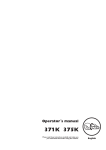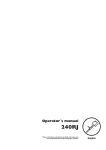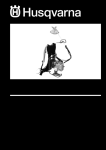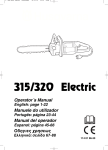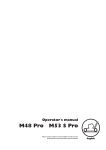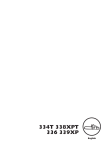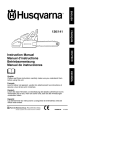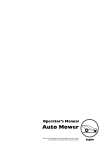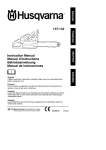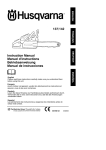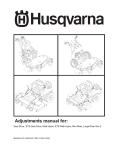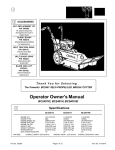Download Husqvarna 136, 141 Brush Cutter User Manual
Transcript
FRANÇAIS 136/141 ENGLISH R DEUTSCH Instruction Manual Manuel d’instructions Betriebsanweisung Manual de instrucciones ESPAÑOL English Please read these instructions carefully make sure you understand them before using this unit. Français Avant d’utiliser cet appareil, veuillez lire attentivement les instructions et assurez--vous de les avoir comprises. Deutsch Lesen Sie diese Hinweise zur Handhabung des Geräts aufmerksam durch. Verwenden Sie es erst, wenn Sie sicher sind, daß Sie alle Anweisungen verstanden haben. Español Lea atentamente las instrucciones y asegúrese de entenderlas antes de utilizar esta unidad. 530088185 11/11/02 IDENTIFICATION (WHAT IS WHAT?) 3 2 1 12 21 14 13 7 6 23 5 20 18 19 8 17 9 15 4 11 16 24 25 1. Cylinder Cover 2. Front Handle 3. Front Handguard 4. Starter Cover 5. Chain Oil Tank 6. Starter Handle 7. Carburator Adjusting Screw 8. Choke Control 9. Rear Handle 10. ON/OFF Switch 11. Fuel Tank 12. Muffler 13. 14. 15. 16. 17. 18. 19. 20. 21. 22. 23. 24. 25. 10 22 Bar Tip Sprocket Saw Chain Saw Bar Optional Bumper Spike Chain Catcher Clutch Cover Right Hand Guard Throttle Control Throttle Lock Bar/Chain Adjustment Tool Chain Tensioning Screw Operator’s Manual Bar Guard IDENTIFICATION OF SYMBOLS WARNING! Read and understand the instruction manual before using the chain saw. This chain saw can be dangerous! Careless or improper use can cause serious or even fatal injury. Always wear appropriate ear protection, eye protection and head protection. Always use two hands when operating the chain saw. WARNING! Contacting the guide bar tip with any object should be avoided; tip contact may cause the guide bar to move suddenly upward and backward, which may cause serious injury. XX_ Measured maximum kickback value without chain brake for the bar and chain combination on the label. 2 SAFETY RULES S Carefully plan your sawing operation in advance. Do not start cutting until you have a clear work area, secure footing, and, if you are felling trees, a planned retreat path. WARNING: Always disconnect spark plug wire and place wire where it cannot contact spark plug to prevent accidental starting when setting up, transporting, adjusting or making repairs except carburetor adjustments. Because a chain saw is a high-speed woodcutting tool, special safety precautions must be observed to reduce the risk of accidents. Careless or improper use of this tool can cause serious injury. OPERATE YOUR SAW SAFELY S Do not operate a chain saw with one hand. Serious injury to the operator, helpers, bystanders or any combination of these persons may result from one-handed operation. A chain saw is intended for two-handed use. S Operate the chain saw only in a well-ventilated outdoor area. S Do not operate saw from a ladder or in a tree. S Make sure the chain will not make contact with any object while starting the engine. Never try to start the saw when the guide bar is in a cut. S Do not put pressure on the saw at the end of the cut. Applying pressure can cause you to lose control when the cut is completed. S Stop the engine before setting the saw down. S Do not operate a chain saw that is damaged, improperly adjusted, or not completely and securely assembled. Always replace bar, chain, hand guard, or chain brake immediately if it becomes damaged, broken or is otherwise removed. S With the engine stopped, hand carry the chain saw with the muffler away from your body, and the guide bar and chain to the rear, preferably covered with a scabbard. PLAN AHEAD S Read this manual carefully until you completely understand and can follow all safety rules, precautions, and operating instructions before attempting to use the unit. S Restrict the use of your saw to adult users who understand and can follow safety rules, precautions, and operating instructions found in this manual. S Wear protective gear. Always use steel-toed safety footwear with non-slip soles; snug-fitting clothing; heavy-duty, non-slip gloves; eye protection such as non-fogging, vented goggles or face screen; an approved safety hard hat; and sound barriers (ear plugs or mufflers) to protect your hearing. Regular users should have hearing checked regularly as chain saw noise can damage hearing. Secure hair above shoulder length. Hearing Protection Snug Fitting Clothing Safety Shoes Safety Hat Eye Protection MAINTAIN YOUR SAW IN GOOD WORKING ORDER S Have all chain saw service performed by a qualified service dealer with the exception of the items listed in the maintenance section of this manual. For example, if improper tools are used to remove or hold the flywheel when servicing the clutch, structural damage to the flywheel can occur and cause the flywheel to burst. S Make certain the saw chain stops moving when the throttle trigger is released. For correction, refer to CARBURETOR ADJUSTMENTS. S Never modify your saw in any way. S Keep the handles dry, clean, and free of oil or fuel mixture. S Keep fuel and oil caps, screws, and fasteners securely tightened. S Use only HusqvarnaR accessories and replacement parts as recommended. Heavy Duty Gloves Safety Chaps S Keep all parts of your body away from the chain when the engine is running. S Keep children, bystanders, and animals a minimum of 30 feet (10 meters) away from the work area. Do not allow other people or animals to be near the chain saw when starting or operating the chain saw. S Do not handle or operate a chain saw when you are fatigued, ill, or upset, or if you have taken alcohol, drugs, or medication. You must be in good physical condition and mentally alert. Chain saw work is strenuous. If you have any condition that might be aggravated by strenuous work, check with your doctor before operating a chain saw. HANDLE FUEL WITH CAUTION S Do not smoke while handling fuel or while operating the saw. S Eliminate all sources of sparks or flame in the areas where fuel is mixed or poured. There should be no smoking, open flames, or work that could cause sparks. Allow engine to cool before refueling. 3 S Mix and pour fuel in an outdoor area on bare ground; store fuel in a cool, dry, well ventilated place; and use an approved, marked container for all fuel purposes. Wipe up all fuel spills before starting saw. S Move at least 10 feet (3 meters) from fueling site before starting engine. S Turn the engine off and let saw cool in a non-combustible area, not on dry leaves, straw, paper, etc. Slowly remove fuel cap and refuel unit. S Store the unit and fuel in an area where fuel vapors cannot reach sparks or open flames from water heaters, electric motors or switches, furnaces, etc. Kickback Path Avoid Obstructions KICKBACK Clear The Working Area WARNING: Avoid kickback which REDUCE THE CHANCE OF KICKBACK can result in serious injury. Kickback is the backward, upward or sudden forward motion of the guide bar occurring when the saw chain near the upper tip of the guide bar contacts any object such as a log or branch, or when the wood closes in and pinches the saw chain in the cut. Contacting a foreign object in the wood can also result in loss of chain saw control. S Rotational Kickback can occur when the moving chain contacts an object at the upper tip of the guide bar. This contact can cause the chain to dig into the object, which stops the chain for an instant. The result is a lightning fast, reverse reaction which kicks the guide bar up and back toward the operator. S Pinch-Kickback can occur when the the wood closes in and pinches the moving saw chain in the cut along the top of the guide bar and the saw chain is suddenly stopped. This sudden stopping of the chain results in a reversal of the chain force used to cut wood and causes the saw to move in the opposite direction of the chain rotation. The saw is driven straight back toward the operator. S Pull-In can occur when the moving chain contacts a foreign object in the wood in the cut along the bottom of the guide bar and the saw chain is suddenly stopped. This sudden stopping pulls the saw forward and away from the operator and could easily cause the operator to lose control of the saw. Avoid Pinch--Kickback: S Be extremely aware of situations or obstructions that can cause material to pinch the top of or otherwise stop the chain. S Do not cut more than one log at a time. S Do not twist the saw as the bar is withdrawn from an undercut when bucking. Avoid Pull--In: S Always begin cutting with the engine at full speed and the saw housing against wood. S Use wedges made of plastic or wood. Never use metal to hold the cut open. S Recognize that kickback can happen. With a basic understanding of kickback, you can reduce the element of surprise which contributes to accidents. S Never let the moving chain contact any object at the tip of the guide bar. S Keep the working area free from obstructions such as other trees, branches, rocks, fences, stumps, etc. Eliminate or avoid any obstruction that your saw chain could hit while you are cutting. When cutting a branch, do not let the guide bar contact branch or other objects around it. S Keep your saw chain sharp and properly tensioned. A loose or dull chain can increase the chance of kickback occurring. Follow manufacturer ’s chain sharpening and maintenance instructions. Check tension at regular intervals with the engine stopped, never with the engine running. Make sure the chain brake nuts are securely tightened after tensioning the chain. S Begin and continue cutting at full speed. If the chain is moving at a slower speed, there is greater chance of kickback occurring. S Cut one log at a time. S Use extreme caution when re-entering a previous cut. S Do not attempt cuts starting with the tip of the bar (plunge cuts). S Watch for shifting logs or other forces that could close a cut and pinch or fall into chain. S Use the Reduced--Kickback Guide Bar and Low--Kickback Chain specified for your saw. MAINTAIN CONTROL Stand to the left of the saw Thumb on underside of handlebar Never reverse hand positions 4 Symmetrical Guide Bar Large Radius Tip Elbow locked S Low--Kickback Chain, designed with a contoured depth gauge and guard link which deflect kickback force and allow wood to gradually ride into the cutter. Thumb on underside of handlebar Low---Kickback Chain Contoured Depth Gauge Elongated Guard Link Deflects Kickback Force And Allows Wood To Gradually Ride Into Cutter S Keep a good, firm grip on the saw with both hands when the engine is running and don’t let go. A firm grip will help you reduce kickback and maintain control of the saw. Keep the fingers of your left hand encircling and your left thumb under the front handlebar. Keep your right hand completely around the rear handle whether your are right handed or left handed. Keep your left arm straight with the elbow locked. S Position your left hand on the front handlebar so it is in a straight line with your right hand on the rear handle when making bucking cuts. Never reverse right and left hand positions for any type of cutting. S Stand with your weight evenly balanced on both feet. S Stand slightly to the left side of the saw to keep your body from being in a direct line with the cutting chain. S Do not overreach. You could be drawn or thrown off balance and lose control of the saw. S Do not cut above shoulder height. It is difficult to maintain control of saw above shoulder height. S Front Hand Guard, designed to reduce the chance of your left hand contacting the chain if your hand slips off the front handlebar. S Position of front and rear handlebars, designed with distance between handles and “in-line” with each other. The spread and “in-line” position of the hands provided by this design work together to give balance and resistance in controlling the pivot of the saw back toward the operator if kickback occurs. WARNING: DO NOT RELY UPON ANY OF THE DEVICES BUILT INTO YOUR SAW. YOU SHOULD USE THE SAW PROPERLY AND CAREFULLY TO AVOID KICKBACK. Reduced--kickback guide bars and low--kickback saw chains reduce the chance and magnitude of kickback and are recommended. Your saw has a low kickback chain and bar as original equipment. Repairs on a chain brake should be made by an authorized servicing dealer. Take your unit to the place of purchase if purchased from a servicing dealer, or to the nearest authorized master service dealer. S Tip contact in some cases may cause a lightning fast reverse REACTION, kicking the guide bar up and back toward the operator. S Pinching the saw chain along the top of the guide bar may push the guide bar rapidly back toward the operator. S Either of these reactions may cause you to lose control of the saw which could result in serious injury.Do not rely exclusively upon the safety devices built into your saw. KICKBACK SAFETY FEATURES WARNING: The following features are included on your saw to help reduce the hazard of kickback; however, such features will not totally eliminate this danger. As a chain saw user, do not rely only on safety devices. You must follow all safety precautions, instructions, and maintenance in this manual to help avoid kickback and other forces which can result in serious injury. S Reduced--Kickback Guide Bar, designed with a small radius tip which reduces the size of the kickback danger zone on the bar tip. A Reduced--Kickback Guide Bar has been demonstrated to significantly reduce the number and seriousness of kickbacks. CHAIN BRAKE S Chain Brake, designed to stop the chain in the event of kickback. Your chain saw is WARNING: equipped with a chain brake that is designed to stop the chain immediately if you get a kickback. The chain brake reduces the risk of accidents, but only you can prevent them. DO NOT ASSUME THAT THE CHAIN BRAKE WILL PROTECT YOU IN THE EVENT OF A KICKBACK. Reduced Kickback Symmetrical Guide Bar Small Radius Tip 5 S An adjusting pin and screw is used to adjust the tension of the chain. It is very important when assembling the bar, that the pin located on the adjusting screw aligns into a hole in the bar. Turning the screw will move the adjustment pin up and down the screw. Locate this adjustment before you begin mounting the bar onto the saw. See illustration below. SAFETY NOTICE: Exposure to vibrations through prolonged use of gasoline powered hand tools could cause blood vessel or nerve damage in the fingers, hands, and joints of people prone to circulation disorders or abnormal swellings. Prolonged use in cold weather has been linked to blood vessel damage in otherwise healthy people. If symptoms occur such as numbness, pain, loss of strength, change in skin color or texture, or loss of feeling in the fingers, hands, or joints, discontinue the use of this tool and seek medical attention. An anti-vibration system does not guarantee the avoidance of these problems. Users who operate power tools on a continual and regular basis must monitor closely their physical condition and the condition of this tool. Inside view of Chain Brake Adjustment located on Chain Brake S Turn the adjusting screw by hand counterclockwise until the adjusting pin just touches the stop. This should allow the pin to be near the correct position. Further adjustment may be necessary as you mount the bar. S Slide guide bar behind clutch drum until guide bar stops against clutch drum sprocket. ASSEMBLY Protective gloves (not provided) should be worn during assembly. ATTACHING THE OPTIONAL BUMPER SPIKE The optional bumper spike may be used as a pivot when making a cut. S Loosen and remove the chain brake nuts and the chain brake from the saw. S Attach the bumper spike (optional) with the two screws as illustrated. Mount the bar S Prepare the chain by checking the proper direction. Without following the illustration it is easy to place the chain on the saw in the wrong direction. Use the illustration of the chain to determine the proper direction. Tip of Bar ATTACHING THE BAR & CHAIN (If not already attached) WARNING: If received assembled, repeat all steps to ensure your saw is properly assembled and all fasteners are secure. Always wear gloves when handling the chain. The chain is sharp and can cut you even when it is not moving! S Loosen and remove the chain brake nuts and the chain brake from the saw. S Remove the plastic shipping spacer (if present). Location of shipping spacer CUTTERS MUST FACE IN DIRECTION OF ROTATION Cutters Depth Gauge Drive Links S Place the chain over and behind the clutch, fitting the drive links in the clutch drum sprocket. Chain Brake Chain Brake Nuts Place chain onto the sprocket Bar Tool 6 S Fit bottom of drive links between the teeth in the sprocket in the nose of the guide bar. S Fit chain drive links in bar groove. S Pull the bar forward until the chain is snug in the guide bar groove. Ensure all drive links are in the bar groove. S Now, install chain brake making sure the adjusting pin is positioned in the lower hole in the guide bar. Remember this pin moves the bar forward and backward as the screw is turned. S Install chain brake nuts and finger tighten only. Once the chain is tensioned, you will need to tighten chain brake nuts. CHAIN TENSION (Including units with chain already installed) NOTE: When adjusting chain tension, make sure the chain brake nuts are finger tight only. Attempting to tension the chain when the chain brake nuts are tight can cause damage. S Recheck chain tension. Chain Brake Nuts WARNING: If the saw is operated with a loose chain, the chain could jump off the guide bar and result in serious injury. WARNING: Muffler is very hot during and after use. Do not touch the muffler or allow combustible material such as dry grass or fuel to do so. FUELING & LUBRICATION Checking the tension: WARNING: Remove fuel cap slow- Use the screwdriver end of the chain adjustment tool (bar tool) to move the chain around the bar. If the chain does not rotate, it is too tight. If too loose, the chain will sag below the bar. Chain Brake Nuts ly when refueling. FUELING ENGINE This engine is certified to operate on unleaded gasoline. Before operation, gasoline must be mixed with a good quality 2-cycle air-cooled engine oil. We recommend HusqvarnaR brand oil. If you do not use this oil, use a good quality 2-cycle air-cooled oil designed to be mixed at a ratio of 40:1. A 40:1 ratio is obtained by mixing 0,125 liter of oil with 5 liters of unleaded gasoline. DO NOT USE automotive or boat oil. These oils will cause engine damage. When mixing fuel follow the instructions printed on the container. Always read and follow the safety rules listed under HANDLE FUEL WITH CAUTION. Chain Adjustment Tool (Bar Tool) Adjusting the tension: Chain tension is very important. Chain stretches during use. This is especially true during the first few times you use your saw. Always check chain tension each time you use and refuel your saw. You can adjust the chain tension by loosening the chain brake nuts and turning the adjusting screw 1/4 of a turn while lifting up on the bar. S If chain is too tight, turn adjusting screw 1/4 turn counterclockwise. S If chain is too loose, turn adjusting screw 1/4 turn clockwise. BAR AND CHAIN LUBRICATION The bar and chain require continuous lubrication. Lubrication is provided by the automatic oiler system when the oil tank is kept filled. Lack of oil will quickly ruin the bar and chain. Too little oil will cause overheating shown by smoke coming from the chain and/ or discoloration of the bar. Only use Bar and Chain Oil for bar and chain lubrication. Oil cap Fuel mix cap Adjusting screw STARTING Chain Brake Nuts Adjusting Screw -- 1/4 Turn S Lift up the tip of the bar and tighten the chain brake nuts with the bar tool. 7 WARNING: The chain must not move when the engine runs at idle speed. If the chain moves at idle speed refer to CARBURETOR ADJUSTMENT within this manual. Avoid contact with the muffler. A hot muffler can cause serious burns. To stop the engine move the ON/STOP switch to the STOP position. To start the engine hold the saw firmly on the ground as illustrated. Make sure the chain is free to turn without contacting any object. CHOKE/FAST IDLE LEVER FULL Use only 15”---18” of rope per pull. Hold saw firmly while pulling starter rope Starter rope handle Left hand on front handle OFF STARTING A WARM ENGINE S Move ON/STOP switch to the ON position. S Pull the choke/fast idle lever out to the full extent; then, push the lever back in completely (to the OFF CHOKE position). This will set the fast idle lock to the start position. S Pull the starter rope quickly with your right hand until the engine starts. S Squeeze and release the throttle trigger to allow engine to return to idle speed. Right foot through rear handle DIFFICULT STARTING (or starting a flooded engine) IMPORTANT POINTS TO REMEMBER When pulling the starter rope, do not use the full extent of the rope as this can cause the rope to break. Do not let starter rope snap back. Hold the handle and let the rope rewind slowly. For cold weather starting, start the unit at FULL CHOKE; allow the engine to warm up before squeezing the throttle trigger. The engine may be flooded if it has not started after 10 pulls. Flooded engines can be cleared of excess fuel by following the warm engine starting procedure listed above. Ensure the ON/STOP switch is in the ON position. Starting could require many pulls depending on how badly unit is flooded. If engine still fails to start, refer to the TROUBLESHOOTING TABLE. NOTE: Do not cut material with the choke/ fast idle lever at the FULL CHOKE position. CHAIN BRAKE STARTING A COLD ENGINE (or warm engine after running out of fuel): NOTE: In the following steps, when the WARNING: If the brake band is worn too thin it may break when the chain brake is triggered. With a broken brake band, the chain brake will not stop the chain. The chain brake should be replaced by an authorized service dealer if any part is worn to less than 1/32” thick. Repairs on a chain brake should be made by an authorized service dealer. Take your unit to the place of purchase if purchased from a servicing dealer, or to the nearest authorized master service dealer. S This saw is equipped with a chain brake. The brake is designed to stop the chain if kickback occurs. S The inertia--activated chain brake is activated if the front hand guard is pushed forward, either manually (by hand) or automatically (by sudden movement). S If the brake is already activated, it is disengaged by pulling the front hand guard back toward the front handle as far as possible. S When cutting with the saw, the chain brake must be disengaged. choke/fast idle lever is pulled out to the full extent, the correct throttle setting for starting is set automatically. S Move ON/STOP switch to the ON position. S Pull the choke/fast idle lever out to the full extent. S Pull starter rope quickly with your right hand a maximum of 10 times. NOTE: If the engine sounds as if it is trying to start before the 10th pull, stop pulling and immediately proceed to the next step. S Push the choke/fast idle lever in completely (to the OFF CHOKE position). S Pull the starter rope quickly with your right hand until the engine starts. S Allow the engine to run for approximately 5 seconds. Then, squeeze and release throttle trigger to allow engine to return to idle speed. Disengaged ON/STOP SWITCH Engaged 8 Braking function control CAUTION: The chain brake must be TREE FELLING TECHNIQUES WARNING: Check for broken or dead branches which can fall while cutting causing serious injury. Do not cut near buildings or electrical wires if you do not know the direction of tree fall, nor cut at night since you will not be ale to see well, nor during bad weather such as rain, snow, or strong winds, etc. If the tree makes contact with any utility line, the utility company should be notified immediately. S Carefully plan your sawing operation in advance. S Clear the work area. You need a clear area all around the tree so you can have secure footing. S The chain saw operator should keep on the uphill side of the terrain as the tree is likely to roll or slide downhill after it is felled. S Study the natural conditions that can cause the tree to fall in a particular direction. Natural conditions that can cause a tree to fall in a particular direction include: S The wind direction and speed. S The lean of the tree. The lean of a tree might not be apparent due to uneven or sloping terrain. Use a plumb or level to determine the direction of tree lean. S Weight and branches on one side. S Surrounding trees and obstacles. Look for decay and rot. If the trunk is rotted, it can snap and fall toward the operator. Check for broken or dead branches which can fall on you while cutting. Make sure there is enough room for the tree to fall. Maintain a distance of 2-1/2 tree lengths from the nearest person or other objects. Engine noise can drown out a warning call. Remove dirt, stones, loose bark, nails, staples, and wire from the tree where cuts are to be made. Plan a clear retreat path to the rear and diagonal to the line of fall. checked several times daily. The engine must be running when performing this procedure. This is the only instance when the saw should be placed on the ground with the engine running. Place the saw on firm ground. Grip the rear handle with your right hand and the front handle with your left hand. Apply full throttle by fully depressing the throttle trigger. Activate the chain brake by turning your left wrist against the hand guard without releasing your grip around the front handle. The chain should stop immediately. Inertia activating function control WARNING: When performing the following procedure, the engine must be turned off. Grip the rear handle with your right hand and the front handle with your left hand. Hold the chain saw approximately 14” (35 cm) above a stump or other wooden surface. Release your grip on the front handle and use the weight of the saw to let the top of the guide bar fall forward and contact the stump. When the tip of the bar hits the stump, the brake should activate. CUTTING METHODS IMPORTANT POINTS S Check chain tension before first use and after 1 minute of operation. See CHAIN TENSION in the ASSEMBLY section. S Cut wood only. Do not cut metal, plastics, masonry, non-wood building materials, etc. S Stop the saw if the chain strikes a foreign object. Inspect the saw and repair or replace parts as necessary. S Keep the chain out of dirt and sand. Even a small amount of dirt will quickly dull a chain and thus increase the possibility of kickback. S Practice cutting a few small logs using the following techniques to get the “feel” of using your saw before you begin a major sawing operation. S Squeeze the throttle trigger and allow the engine to reach full speed before cutting. S Begin cutting with the saw frame against the log. S Keep the engine at full speed the entire time you are cutting. S Allow the chain to cut for you. Exert only light downward pressure. If you force the cut, damage to the bar, chain, or engine can result. S Release the throttle trigger as soon as the cut is completed, allowing the engine to idle. If you run the saw at full throttle without a cutting load, unnecessary wear can occur to the chain, bar, and engine. S To avoid losing control when cut is complete, do not put pressure on saw at end of cut. S Stop the engine before setting the saw down after cutting. Plan a clear retreat path Direction of Fall 45_ FELLING LARGE TREES 9 (6 inches in diameter or larger) The notch method is used to fell large trees. A notch is cut on the side of the tree in the desired direction of fall. After a felling cut is made on the opposite side of tree, the tree will tend to fall into the notch. NOTE: If the tree has large buttress roots, remove them before making the notch. If using saw to remove buttress roots, keep saw chain from contacting ground to prevent dulling of the chain. NOTCH CUT AND FELLING THE TREE S Make notch cut by cutting the top of the notch first. Cut through 1/3 of the diameter of the tree. Next complete the notch by cutting the bottom of the notch. See illustration. Once the notch is cut, remove the notch of wood from the tree. Final cut here. 2 inches above center of notch. First cut Notch Second cut S After removing the wood from the notch, make the felling cut on the opposite side of the notch. This is done by making a cut about two inches higher than the center of the notch. This will leave enough uncut wood between the felling cut and the notch to form a hinge. This hinge will help prevent the tree from falling in the wrong direction. Hinge holds tree on stump and helps control fall Opening of felling cut Closing of notch NOTE: Before felling cut is complete, use wedges to open the cut when necessary to control the direction of fall. To avoid kickback and chain damage, use wood or plastic wedges, but never steel or iron wedges. S Be alert to signs that the tree is ready to fall: cracking sounds, widening of the felling cut, or movement in the upper branches. S As tree starts to fall, stop saw, put it down, and get away quickly on your planned retreat path. S DO NOT cut down a partially fallen tree with your saw. Be extremely cautious with partially fallen trees that may be poorly supported. When a tree doesn’t fall completely, set the saw aside and pull down the tree with a cable winch, block and tackle, or tractor. CUTTING A FALLEN TREE (BUCKING) Bucking is the term used for cutting a fallen tree to the desired log size. WARNING: Do not stand on the log being cut. Any portion can roll causing loss of footing and control. Do not stand downhill of the log being cut. IMPORTANT POINTS S Cut only one log at a time. S Cut shattered wood very carefully; sharp pieces of wood could be flung toward operator. S Use a sawhorse to cut small logs. Never allow another person to hold the log while cutting and never hold the log with your leg or foot. S Do not cut in an area where logs, limbs, and roots are tangled such as in a blown down area. Drag the logs into a clear area before cutting by pulling out exposed and cleared logs first. TYPES OF CUTTING USED FOR BUCKING WARNING: If saw becomes pinched or hung in a log, don’t try to force it out. You can lose control of the saw resulting in injury and/or damage to the saw. Stop the saw, drive a wedge of plastic or wood into the cut until the saw can be removed easily. Restart the saw and carefully reenter the cut. To avoid kickback and chain damage, do not use a metal wedge. Do not attempt to restart your saw when it is pinched or hung in a log. Use a wedge to remove pinched saw Turn saw OFF and use a plastic or wooden wedge to force cut open. Overcutting begins on the top side of the log with the bottom of the saw against the log. When overcutting use light downward pressure. Overcutting Undercutting Undercutting involves cutting on the underside of the log with top of saw against the log. When undercutting use light upward pressure. Hold saw firmly and maintain control. The saw will tend to push back toward you. WARNING: Never turn saw upside down to undercut. The saw cannot be controlled in this position. Always make your first cut on the compression side of the log. The compression side of the log is where the pressure of the log’s weight is concentrated. 10 1st Cut First cut on compression side of log 2nd Cut Second cut Second cut LIMBING AND PRUNING First cut on compression side of log BUCKING WITHOUT A SUPPORT S Overcut through 1/3 of the diameter of the log. S Roll the log over and finish with a second overcut. S Watch for logs with a compression side to prevent the saw from pinching. See illustrations for cutting logs with a compression side. BUCKING USING A LOG OR SUPPORT STAND S Remember your first cut is always on the compression side of the log. (Refer to the illustrations below for your first and second cut) S Your first cut should extend 1/3 of the diameter of the log. S Finish with your second cut. Using a log for support 2nd Cut WARNING: Be alert for and guard against kickback. Do not allow the moving chain to contact any other branches or objects at the nose of the guide bar when limbing or pruning. Allowing such contact can result in serious injury. WARNING: Never climb into a tree to limb or prune. Do not stand on ladders, platforms, a log, or in any position which can cause you to lose your balance or control of the saw. IMPORTANT POINTS S Work slowly, keeping both hands firmly gripped on the saw. Maintain secure footing and balance. S Watch out for springpoles. Use extreme caution when cutting small size limbs. Slender material may catch the saw chain and be whipped toward you or pull you off balance. S Be alert for springback. Watch out for branches that are bent or under pressure. Avoid being struck by the branch or the saw when the tension in the wood fibers is released. S Keep a clear work area. Frequently clear branches out of the way to avoid tripping over them. LIMBING 1st Cut 1st Cut 2nd Cut Using a support stand 2nd Cut S Always limb a tree after it is cut down. Only then can limbing be done safely and properly. S Leave the larger limbs underneath the felled tree to support the tree as you work. S Start at the base of the felled tree and work toward the top, cutting branches and limbs. Remove small limbs with one cut. S Keep the tree between you and the chain. Cut from the side of the tree opposite the branch you are cutting. S Remove larger, supporting branches with the cutting techniques described in BUCKING WITHOUT A SUPPORT. S Always use an overcut to cut small and freely hanging limbs. Undercutting could cause limbs to fall and pinch the saw. PRUNING 1st Cut WARNING: Limit pruning to limbs shoulder height or below. Do not cut if branches are higher than your shoulder. Get a professional to do the job. S Make your fist cut 1/3 of the way through the bottom of the limb. 11 S Next make a 2nd cut all the way through the limb. Then cut a third overcut leaving a 1 to 2 inch collar from the truck of the tree. Second cut Third cut Collar BAR MAINTENANCE If your saw cuts to one side, has to be forced through the cut, or been run with an improper amount of bar lubrication it may be necessary to service your bar. A worn bar will damage your chain and make cutting difficult. Replace your bar if bent or the inside rails of the bar are worn. S Clean the oil holes after each 5 hours of operation. S Remove sawdust from bar groove periodically with a wire or putty knife. Remove Sawdust From Guide Bar Groove First cut Pruning technique Oil Holes SERVICE CHAIN SHARPENING WARNING: Disconnect the spark plug before performing maintenance except for carburetor adjustments. We recommend all service and adjustments not listed in this manual be performed by an authorized service dealer. AIR FILTER CAUTION: Do not clean filter in gasoline or other flammable solvent to avoid creating a fire hazard or producing harmful evaporative emissions. Cleaning the air filter: A dirty air filter decreases engine performance and increases fuel consumption and harmful emissions. Always clean after every 5 hours of operation. S Clean the cover and the area around it to keep dirt and sawdust from falling into the carburetor chamber when the cover is removed. S Remove the parts as illustrated below. S Wash the filter in soap and water. Rinse in clean cool water. Air dry completely before reinstalling. S Reinstall parts. Chain sharpening is a complicated task that requires special tools. We recommended you refer chain sharpening to a professional chain sharpener. IGNITION TIMING Ignition timing is fixed and nonadjustable. SPARK PLUG The spark plug should be replaced each year to ensure the engine starts easier and runs better. S Loosen 3 screws on cylinder cover. S Remove the cylinder cover. S Pull off the spark plug boot. S Remove spark plug from cylinder and discard. S Replace with Champion RCJ--7Y spark plug and tighten securely with a 3/4 inch socket wrench. Spark plug gap should be 0,5 mm. S Reinstall the spark plug boot. S Reinstall the cylinder cover and 3 screws. Tighten securely. Air Filter Spark Plug Boot STORAGE Air Filter Screws CARBURETOR ADJUSTMENTS Your carburetor is equipped with limiter caps. Carburetor adjustment is a complicated task. We recommend that you take your unit to an authorized service dealer. Damage will occur if you turn the needles beyond the limiter stops. WARNING: Stop engine and allow to cool, and secure the unit before storing or transporting in a vehicle. Store unit and fuel in an area where fuel vapors cannot reach sparks or open flames from water heaters, electric motors or switches, furnaces, etc. Store unit with all guards in place. Position so that any sharp object cannot accidentally cause injury to passersby. Store the unit out of reach of children. 12 S Before storing, drain all fuel from the unit. Start engine and allow to run until it stops. S Clean the unit before storing. Pay particular attention to the air intake area, keeping it free of debris. Use a mild detergent and sponge to clean the plastic surfaces. S Do not store the unit or fuel in a closed area where fuel vapors can reach sparks or an open flame from hot water heaters, electric motors or switches, furnaces, etc. S Store in a dry area out of the reach of children. TROUBLESHOOTING TABLE WARNING: Always stop unit and disconnect spark plug before performing all of the recommended remedies below except remedies that require operation of the unit. TROUBLE CAUSE REMEDY Engine will not start or will run only a few seconds after starting. S Ignition switch off. S Engine flooded. Engine will not idle properly. S Carburetor requires adjustment S Crankshaft seals worn. S Air filter dirty. S Spark plug fouled. S Move ignition switch to ON. S See “Difficult Starting” in Operation Section. S Fill tank with correct fuel mixture. S Install new spark plug. S Check for dirty fuel filter; replace. Check for kinked or split fuel line; repair or replace. S Contact an authorized service dealer. Engine will not accelerate, lacks power, or dies under a load. Engine smokes excessively. S Fuel tank empty. S Spark plug not firing. S Fuel not reaching carburetor. S Contact an authorized service dealer. S Clean or replace air filter. S Clean or replace plug and regap. S Contact an authorized service dealer. S Carburetor requires adjustment. S Empty fuel tank and refill with correct fuel mixture. S Too much oil mixed with gasoline. 13 DECLARATION OF CONFORMITY relating to 2000/14/EC EU Declaration of Conformity relating to 2000/14/EC We, Poulan/Weed Eater, Division Electrolux North America, Inc., Texarkana, TX, 75501, USA, Tél. : +1 903 223 4100, declare under sole responsibility that the Husqvarna models 136/141 chain saws were assessed in accordance with Annex V of the DIRECTIVE and from serial numbers 2001--305(N or D)00001 and onwards, conforms to the provisions of the DIRECTIVE. The net power is 1.6 kW or 1.9 kW. For the model 136, the measured sound power is 107,7 dB and the guaranteed sound power is 118 dB. For the model 141, the measured sound power is 108,2 dB and the guaranteed sound power is 118 dB. Texarkana 01--12--17 Michael S. Bounds, Director Product Safety and Standards DECLARATION OF CONFORMITY relating to 89/392/EEC EU declaration of conformity (Directive 89/392/EEC, Annex II, A) (Only applies to Europe) We, Poulan/Weed Eater, Division Electrolux North America, Inc., Texarkana, TX 75501, USA, Tel: +1 903 223 4100, declare under sole responsibility that the Husqvarna models 136/141 chain saws from serial numbers 2001--305(N or D)00001 and onwards, follows the provisions of the DIRECTIVES: 89/392/EEC (machinery) and 89/336/EEC (electromagnetic compatibility), including amendments and is in conformity with the following standards: EN 292--2, EN 608 and CISPR 12. The supplied chain saw conforms with the sample that underwent the EU type approval. Notified body, 0404 the Swedish Machinery Testing Institute, Fyrisborgsgatan 3 S--754 50 Uppsala, Sweden, has carried out EU type approval. The certificate(s) are numbered: 136 -- 404/98/574, 141 -- 404/98/575. Texarkana 01--12--17 Michael S. Bounds, Director Safety and Standards 14 TECHNICAL DATA SHEET Engine Cylinder volume, cm3 Stroke, mm Idle speed, rpm Recommended max. speed, unloaded, rpm Power, kW 136 36 32 3,000 Noise levels 136 141 Equivalent (see note 1) noise pressure level at operator ’s ear, measured according to relevant international standards, dB(A) 98 98 Equivalent (see note 1) noise power level, measured according to relevant international standards, dB(A) 107,7 108,2 141 40 32 3,000 13,000 13,000 1,6 1,9 Ignition system Manufacturer Phelon Phelon Type of ignition system CD CD Spark plug Champion Electrode gap, mm 0,5 0,5 Fuel and lubrication system Manufacturer Walbro Walbro Carburetor type WT 289 WT 289 Fuel capacity, litre 0,41 0,41 Oil pump capacity at 8500 rpm, ml/min 6 -- 8 6 -- 8 Oil capacity, litre 0,29 0,29 Type of oil pump Automatic Weight Without bar and chain, kg 4,6 Length Inches 13 15 H30 4,6 Vibration levels (see note 2) 4,9 Front handle, m/s2 7,7 Rear handle, m/s2 Chain/bar Standard bar length, in/cm 13/33 Recommended bar lengths, in/cm 13/33 Usable cutting length, in/cm 12,5/32 Chain speed at maximum power, m/sec 16,3 Pitch, inches 0,325 4,8 6,5 15/38 15/38 14,5/37 16,3 0,325 Thickness of drive link, mm 1,3 BAR CHAIN No. of teeth on drive sprocket 7 Pitch Max Inches Tip Radius _ Note 1: Equivalent noise level is, according to 0,325 10T Husqvarna H30 ISO 7182 and ISO 9207, calculated as the 0,325 10T Husqvarna H30 time--weighted energy total for noise levels under various working conditions with the following time distribution, 1/2 idle, 1/3 full load, 1/3 full speed. Note 2: Equivalent vibration level is, according to ISO 7505, calculated as the time--weighted energy total for vibration levels under various working conditions with the following time distribution: 1/3 idle, 1/3 full load, 1/3 full speed. 0,325 0,050/ 1,3 3/16 4,8 85 30 10 2002 YEAR OF CONSTRUCTION: MANUFACTURER’S ADDRESS: Husqvarna SE--561 82 Huskvarna Huskvarna, Sweden 15 0,025/ 0,65 13/33/56 15/38/64 We hope you find the links below useful. For further gardening information visit www.GardenResources.co.uk Blower Vacs Cultivators Electric chainsaws Garden tractors Hover mowers Lawn scarifiers Petrol hedge cutters Ryobi strimmers Brush cutters Cylinder lawn mowers Fertiliser spreaders Garden vacuums Husqvarna chainsaws Lawn tractors Ride on lawn mowers Scarifiers Brushcutters Cylinder mowers Chainsaws Echo chainsaws Chain saws Echo Strimmers Garden blowers Garden rollers Garden shredders Hayter lawn mowers Kawasaki brush cutters Leaf blowers Ride on mowers Hedge cutters Hedgecutters Kawasaki strimmers Leaf vacuums Rotary mowers Lawn mowers Petrol chainsaws Rotavators Westwood lawn tractors Blower Vacs Westwood ride on mowers Chain Saws Strimmers Westwood tractors Chainsaws Brush Cutters Brushcutters Cultivators Echo Chainsaws Echo Strimmers Electric Chainsaws Garden Shredders Hedgecutters Fertiliser Spreaders Garden Tractors Cylinder Lawn Mowers Garden Blowers Garden Rollers Lawn Rollers Garden Vacuums Hedge Cutters Lawn Mowers Petrol Chainsaws Scarifiers Petrol Hedge Cutters Ryobi Strimmers Hayter Lawn Mowers Kawasaki Brush Cutters Leaf Blowers Ride on Mowers Rotovators Patio Heaters Gas Greenhouse Heaters Christmas Gardening Gifts Hover Mowers Patio Heater Covers Stainless Steel Patio Heaters Garden Tractors Husqvarna Chainsaws Lawn Tractors Ride on Lawn Mowers Garden Patio Heaters Garden Heaters Table Top Patio Heaters Ride on Lawn Mowers Outdoor Patio Heaters Greenhouse Heaters Patio Heaters UK Ride on Mowers Also See Gardening Tools Direct, for lawn mowers, brush cutters, chainsaws Gardening Supply for patio heaters, lawn mowers, chainsaws Garden Tractor, for lawn tractors and ride on mowers Kawasaki Strimmers Leaf Vacuums Rotary Mowers Gas Patio Heaters Green House Heaters Patio Heaters with Covers

















